Aylesbury Vale Area Design Supplementary Planning Document
8. Household extensions
8.1 Introduction
8.1.1 Building an extension is not only a matter of enclosing additional floorspace; external appearance and the effect on neighbours also have to be considered. Designing extensions to respect the character and appearance of existing buildings is not only architectural good manners, it also widens the spectrum of prospective buyers if and when you put your home on the market.
8.1.2 Some smaller-scale extensions may constitute 'permitted development' which means they do not need planning permission. However, some exceptions may apply and so householders are encouraged to use the Planning Portal guidance on planning permission and the council's pre-application servicefor advice on whether planning permission is required.
8.1.3 If planning permission is required, the council has supporting information for householder applications as well as a Local Validation List to help people in preparing applications and ensure all necessary information is included. Refer to the 'Supporting information for your planning application' pages of the council's website.
8.1.4 Building Regulations approval may also be required for any extensions or alterations to a dwelling. Advice on building regulations can be provided by the council's building control service.
8.1.5 If a building is Statutorily Listed or is located within a Conservation Area or within the Chilterns AONB, some forms of development or alteration, that would otherwise be classed as permitted development, will require planning permission, Listed Building Consent or combinations of these. This is to protect the recognised importance of the existing building or its setting.
8.1.6 Any applications that affect a Listed Building or Conservation Area will require a Design and Access Statement and Heritage Impact Assessment.
8.1.7 Extensions to historic buildings can be harmful if their significance is not fully understood. For listed buildings particular weight is placed on retaining the identity, appearance, character and special interest of the building and in some cases building extensions will not be considered to be desirable. Further advice on alterations to your property can be requested through pre-application advice.
8.1.8 More information on how to understand the significance of a heritage asset can be found in the Historic England Good Practice Advice Note 2 – Managing significance in Decision taking in the Historic Environment.

Figure 8.1: A contemporary extension which is physically subservient to the original
8.1.9 When planning a household extension consideration must be given to the potential impact on wildlife and biodiversity, for instance through the demolition of older buildings or roof spaces, removal of trees, scrub, hedgerows or alterations to water courses. Whenever possible mature trees should be retained and these will need to be appropriately protected during construction. Where impacts on biodiversity are likely a biodiversity survey and report will be required. Refer also to Principle DES13 which requires a biodiversity net gain for all development.
8.2 Responding to local character and neighbours
Principle DES55: Respond to local character
Respond to the character of the area and immediate neighbourhood within which your property is located.
Use this character as a starting point for design in terms of building form, size, position within the plot and relationship to plot boundaries.
Use simple uncomplicated building forms.
Use building materials and details typical of your area or demonstrate how the materials chosen are appropriate.
Principle DES56: Consider your neighbours
Make sure proposed extensions do not intrude upon a neighbour's privacy.
All extensions should take into account the impact on neighbouring properties and should not cause significant harm to the amenities of existing nearby residents in terms to the impact on privacy, outlook, daylight and sunlight, and noise, air and light pollution.
Any extension to a house should not lead to an oppressive or overbearing impact, which would be harmful to the amenity of occupiers of nearby neighbouring dwellings.
In particular, two storey extensions should not encroach beyond a 45 degree line taken from the edge of the nearest ground or first floor window of a habitable room of a neighbouring property.
Any side facing upper floor windows to habitable rooms (e.g. bedrooms) need to be carefully located and/or designed to ensure they do not cause overlooking problems for neighbouring properties.
Carefully consider the position of new garages to avoid an increase in noise and disturbance from vehicle movements.


LEFT Figure 8.2: New openings on flank elevations can lead to problems of overlooking. RIGHT Figure 8.3: The 45 degree rule: The proposed extension should not project beyond the ‘45 degree line’ (indicated by the dashed line) into the neighbours protected area.
Reason
8.2.1 Privacy will be infringed by the construction of an extension which allows views into a neighbouring property or a hitherto secluded garden. The council will wish to avoid situations which diminish the privacy of neighbour's property and will, for this reason, resist balconies, roof gardens, first floor conservatories and flank windows which would permit views into adjacent or nearby properties.
8.2.2 Since the council will take account of any objections from neighbours when assessing a planning application it is advisable to first discuss your proposal with any neighbour who may be affected.
8.2.3 A neighbour's permission is required if foundations will encroach, or if an extension will overhang or attach to their property (a Deed or Party Wall agreement may have to be drawn up to adequately cover these issues). In addition, a neighbour's consent will be needed if access to their property is necessary during construction.
8.3 Scale, form and massing
Principle DES57: Extensions should besubservient tothescale,formand massing of the original dwelling
The original building should remain the dominant element of the property whether you have one extension or several. The effect of any extension should not overwhelm the house from any given viewpoint.
Extensions should not result in a significant loss to the private amenity area of the dwelling.
Any existing external access from the front of the dwelling to the rear garden is a significant asset to service the garden. Consideration should be given to the value of retaining this access.
Extensions should use simple, uncomplicated building forms to compliment and coordinate with the scale, form and massing of the original dwelling.
Applicants should avoid proposals that wrap around the existing dwelling and involve complicated roof forms. This is likely to result in a bulky appearance.


Left: Figure 8.4: Extensions which are smaller, lower and which follow the design of the original houses are normally acceptable. Right: Figure 8.5: A lower, set back extension which repeats the overall shape and design of the house.
Reason
8.3.1 Extensions that appear subordinate to the original dwelling can help to maintain the character and integrity of the original dwelling. Setting back an extension from the main building line and / or proposing extensions that are lower / smaller in scale will help to ensure this.
8.3.2 Once an extension begins to match or exceed the size of the original building then the architectural integrity of the original structure tends to become lost.

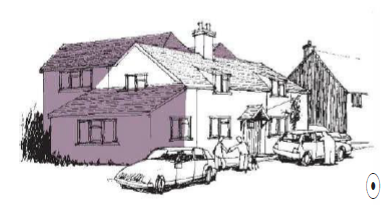
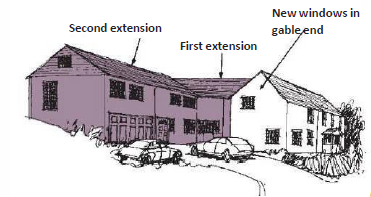


Left: Figure 8.9: Extensions of similar form, but of subordinate size, are generally acceptable, subject to all other criteria set out in this chapter. Centre: Figure 8.10: The scale and massing of the extension bares no relationship to the existing dwelling. Right: Figure 8.11: The extension has an appropriate scale and massing in relation to the original dwelling.

Left: Figure 8.12: Multiple extensions over time can have a compound impact and overwhelm the original dwelling. Centre: Figure 8.13: The size of the extension overwhelms the original dwelling. Right: Figure 8.14: Extensions that wrap around the existing dwelling should be avoided.
Principle DES58: Respond to the design of the original dwelling
Extensions should respond to the design of the original dwelling and applicants should demonstrate how local character has informed the design proposal.
Applicants that do not use materials to match those of the existing dwelling should demonstrate the appropriateness of the alternatives proposed.
Owners of Listed Buildings or buildings in Conservation Areas should also make use of the Statutory List, Conservation Area Character Appraisals or any other assessment of the building's significance when considering an extension so that their design sustains or enhances the features that contribute to its significance or better reveals them.
The position, size, proportion, height and style of new windows and doors and the ratio of solid wall to openings all help to define the character of a dwelling. It is important, therefore, that the extension responds to the existing pattern of window and door openings.

Left: Figure 8.15: A polite extension which maintains the character of the existing house. Right: Figure 8.16: Extensions built in the past generally show a family likeness to the shape of the original house
Reason
8.3.3 There are generally two design approaches that can be adopted when considering extending a property.
8.3.4 The first is to consider the materials, architectural features, window sizes and proportions of the existing building and to recreate this style to design an extension that matches or complements the existing building.
8.3.5 The second is to consider the proportion, materials, architectural features and window sizes of the existing building and to develop a contemporary response to those by taking cues from the key aspects.
8.3.6 In the former case, an extension might go unnoticed. In the latter case the extension would be different yet compatible or complementary.
8.3.7 Both options can create successful, well designed extensions that can be mutually beneficial to both the house and the wider area. The best extensions are architecturally attractive in their own right.

Figure 8.17: Designing an extension to respond to the character of the existing property

Left: Figure 8.18: Despite the set back this prominent extension does not respect the design of the original building. Right: Figure 8.19: The use of architectural good manners provides a scheme that is more responsive to the existing dwelling.
8.4 Detailed principles
Principle DES59: Side extensions
Side extensions should subservient to the original dwelling and normally be set back from the front of the house to retain the proportions of the original building and reduce the visual impact of the join between existing and new.
Extensions that close an important gap within the street scene or lead to a terracing effect will not be accepted.
Two storey extensions should generally be constructed with the same angle of pitch as the existing roof.
The design of all side extensions should take into account the impact on neighbouring properties in terms of overlooking, overshadowing and over dominance.

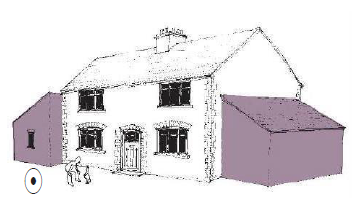
Left: Figure 8.20: The infilling of gaps between buildings is often detrimental to visual amenity. Right: Figure 8.21: Side extensions should be set back from the main building line.
Reason
8.4.1 In built-up areas, the gaps between dwellings can often be small. Cumulatively, these gaps can make an important contribution to the character of an area. Extending at two storeys to the side of a detached or semi-detached dwelling can result in development right up to the site boundary, resulting in an inappropriate 'terracing effect'.
8.4.2 The problem can be exacerbated where an extension has the same roofline as the original building and where a neighbouring property already lies on, or close to, the boundary.
8.4.3 To reduce such a 'terracing effect', it is desirable to maintain a gap between the extension and the site boundary and for the extension to have a lower ridge height than the main building. The extent of the gap should be determined by the pattern of development in the area but, in general, it should not be less than one metre wide in urban areas and a greater space may be required on the edge of towns or in rural areas in order to preserve the open character of an area.
8.4.4 An alternative way of avoiding a terracing effect is to set the first floor element of the extension back from the front elevation – it should be set back at least one third of the depth of the dwelling.
Principle DES60: Front extensions, canopies and porches
The front elevation of a house is the most vulnerable to unsympathetic alteration. Only small additions which do not harm the quality or character of the building are likely to be acceptable.
Front extensions will be resisted where they have a significant impact on the street scene or are damaging to the appearance of a dwelling.
Modest front extensions or porches that reflect the character of the existing property in terms of their scale, details and materials are more likely to be acceptable. Porches should be in proportion with the main dwelling.
Front extensions are more likely to be acceptable where the building line is staggered or where the dwelling is set well back from the road. They should normally be designed with a pitched roof.
The council will not normally grant permission for a front extension (either at single or two storeys) which protrudes beyond a 45 degree line (drawn in the horizontal plane) from the centre of the nearest window in a neighbouring house or flat (refer to Figure 9.1). Windows to a hall, bathroom, utility room, cloakroom or pantry are discounted.


Left: Figure 8.22: Porches of similar form and materials to the dwelling are generally acceptable. Right: Figure 8.24: Porch design does not relate well to the shape or design of the building.
Reason
8.4.5 Extending terraced and semi-detached dwellings represents the most significant challenge in terms of potential loss of residential amenity due to the close proximity of neighbouring properties. Problems can be mitigated by limiting the scale of the proposed extension and applying the 45 degree rule (refer to Figure 8.1). Single storey extensions are easier to accommodate successfully. An alternative solution is for neighbours of adjoining properties to work together to extend both dwellings concurrently.
8.4.6 Single storey rear extensions and conservatories often do not need planning permission as they can be built under 'permitted development' rights. The council's planning service can advise on whether planning permission is required.
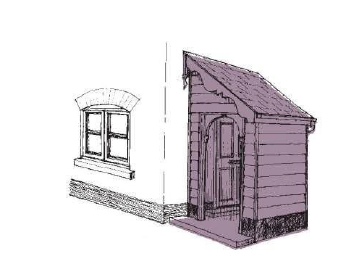
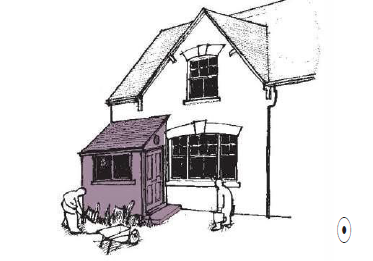
Left: Figure 8.23: Historic porch designs often picked up the architectural characteristics of the house. Right: Figure 8.25: Porch extension is built too close to the principal ground floor window.
Principle DES61: Rear extensions
Rear extensions should not have a harmful effect on neighbouring properties in terms of privacy, overshadowing or overbearing.
In the interest of amenity the distance back from the original main rear elevation is restricted. This distance should normally be no more than three metres in the case of a terraced house and four metres for a semi-detached house.
An adequate distance between facing habitable rooms must be retained to enable people to feel comfortable in their own homes (refer to Principle DES41).
Rear extensions should not have a detrimental impact on the existing dwellings usable amenity space.
The council will not normally grant permission for a rear extension of more than single storey height if any part of that extension protrudes beyond a 45 degree line (drawn in the horizontal plane) from the centre of the nearest window to a habitable room of a neighbouring dwelling, on the same elevation as the rear of the extended property.
The 45 degree line is intended to prevent undue loss of daylight or sunlight to neighbouring properties, to avoid excessive shadowing of gardens, to protect residential amenity and preserve a reasonable standard of outlook. Refer also to Principle DES56 and Figure 8.3.

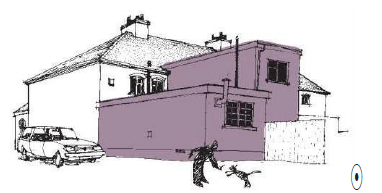
Left: Figure 8.26: Sunlight should be considered even where extensions comply with the 45 degree guidelines. Right: Figure 8.27: Bulky, box like extensions should be avoided in favour of smaller additions which respect the form of the original building.
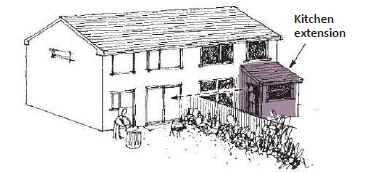
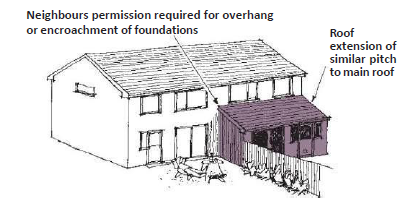
Left: Figure 8.28: Flank doorways can lead to overlooking. Right: Figure 8.29: Extensions across the back of buildings will make the existing rooms darker inside than before.
Principle DES62: Loft conversions and roof extensions
As a general rule extensions that alter the existing ridge of the roof or significantly alter the roof profile of a building will not be accepted.
All two storey extensions should generally have full pitched roofs clad in suitable materials. It may be that a better quality roof material than those on the original could be used (i.e. the original building could have been inappropriately retiled). Natural slate or plain clay roof tiles are preferred on older properties.
Single storey extensions, which are visible from a public area, should generally have pitched roofs. Pitched roofs are also preferred on single storey rear extensions.
Dormer windows should be designed as features principally to provide light and ventilation. They should be small and should sit appropriately in the roof-slope, well above the eaves line, well below the ridgeline and set in from the gable ends. Two or three smaller dormers are often more successful than a single large dormer.
Where a clear rhythm of fenestration is established, the position and proportion of dormer windows should respond to existing windows and/or doors.
Dormers should generally have pitched roofs, be physically small and set into the roof slope so that they are not a strident feature in the roof as a whole. Rear roof slopes, which are less visible, may be able to accept larger additions but these need to be carefully designed as over-dominant or box-like roof extensions can be particularly incongruous. Alterations to the roof, as a whole, should not destroy the original roof form and the materials selected should be compatible with the existing roof material. Rooflights should be small and preferably positioned on less prominent roof slopes.
Flat roof dormers may be acceptable to the rear of properties provided they don't rise above the main ridge of the roof, are subservient to the main dwelling and do not dominate the roof plane, do not impact on the privacy of neighbours and that their design is informed by the character and appearance of the existing dwelling and the surrounding area.


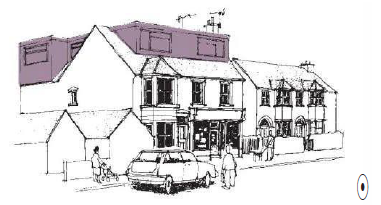
Left: Figure 8.30: Small, vertically proportioned dormers designed to respect the character of the house are normally acceptable. Centre: Figure 8.31: Bulky dormers of unsympathetic appearance detract from the elevation below. Right: Figure 8.32: Box-like roof additions diminish architectural integrity and improverish the street scene.
Reason
8.4.7 A loft conversion is a space efficient means of extending the amount of living accommodation in a dwelling. However if it is out of scale with the roofscape and proportions of a dwelling it can have significant impact on the character of both the dwelling and the streetscape.
Principle DES63: Car parking and garages
Building extensions may reduce the potential for on plot car parking and result in this car parking being shifted onto the street. In many locations this will be unacceptable.
Residential extensions that increase the impact of car parking through a reduction in the space available for landscaping that helps to soften this car parking should also be avoided.
Where residential extensions are proposed to provide garages these must designed so that they appear to belong the dwelling and to be subservient to it. This can be achieved through the use of similar materials and similar or steeper roof pitches and by stepping the garage back behind the building line of the dwelling.

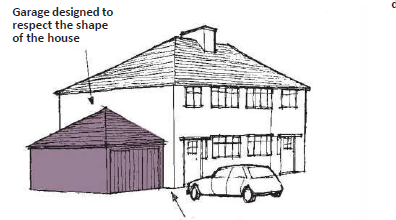
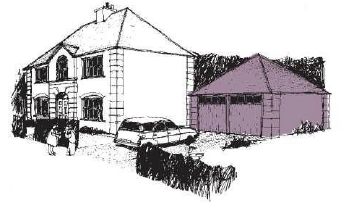
Left: Figure 8.32: Box-like roof additions diminish architectural integrity and improverish the street scene. Centre: Figure 8.36: Garage design which appears to belong to the existing house. Right: Figure 8.37: Garages which follow the materials used on the house, set back in a subordinate position and with planting are generally acceptable.

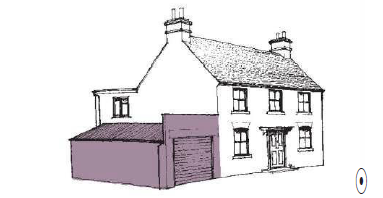
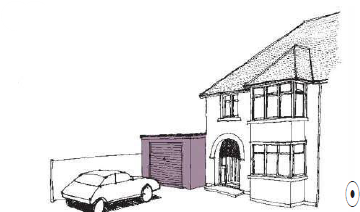
Left: Figure 8.38: Gradually increasing the size of a house inevitably leads to greater demands for off-street parking, often to the detriment of visual amenity. Right: Figure 8.39: The use of parapets on garages is not encouraged. A preferred arrangement is for pitched roofs of similar form to the main roof. Centre: Figure 8.40: Garages which are forward of the main building line and of dissimilar shape are unlikely to receive permission.
How to use
This table provides a checklist for use by both the applicant and planning officer to check that appropriate consideration has been given to the design of a household extension as part of an application.
PROCESS: Have you read, understood and applied the principles set our above?
The adjacent table summarises the key principles set out within this section and can be used by applicant and officer as a checklist.
Applicants will be expected to demonstrate to the council that they have responding adequately to all relevant principles in preparing their proposals, or provide a justification for any failure to do so.
|
PRINCIPLE |
DESCRIPTION |
CHECK |
|
DES55: Responding to local character |
Has the applicant demonstrated how the proposal responds to and respects the character of the area and the immediate neighbourhood? |
|
|
DES56: Consider your neighbours |
Has the applicant considered and demonstrated that the proposal does not cause significant harm to neighbouring properties in relation to overshadowing, privacy or an oppressive or overbearing impact? |
|
|
Does the proposal comply with the 45 degree rule? |
||
|
DES57: Scale, form and massing |
Is the extension a simple, uncomplicated building form that compliments and coordinates with the scale, form and massing of the original dwelling? The original building should remain the dominant element of the property. |
|
|
Is the roof form appropriate to the original dwelling? Generally this should be constructed with the same angle of pitch as the existing roof. |
||
|
DES58: Respond to original dwelling |
Do the materials proposed match those of the existing dwelling or has the applicant demonstrated the appropriateness of the alternatives proposed? |
|
|
Does the proposed extension respond to the existing pattern of window and door openings? |
||
|
DES59: Side extensions |
Is the side extension set back from the front of the house? If not, has the reason been justified? |
|
|
Does the side extension retain important gaps within the street scene and avoid creating a 'terracing effect'? |
||
|
DES60: Front extension, canopies and porches |
Does the front extension, canopy or porch reflect the character of the property in terms of scale, details and materials? |
|
|
DES61: Rear extensions |
Does the rear extension avoid detrimental impact on the existing dwelling's usable amenity space? |
|
|
DES62: Loft conversions and roof extensions |
Are any proposed dormer roof extensions set within the roof slope? |
|
|
Does the position and proportion of dormer windows respond to the location of existing windows and/or doors? |
||
|
DES63: Car parking / garages |
Does the proposed extension impact on the potential to park on the plot or increase the visual impact of existing parking? |
|
|
If a garage is proposed is it designed in a manner that makes it appear to belong to the dwelling and be subservient to it? |





